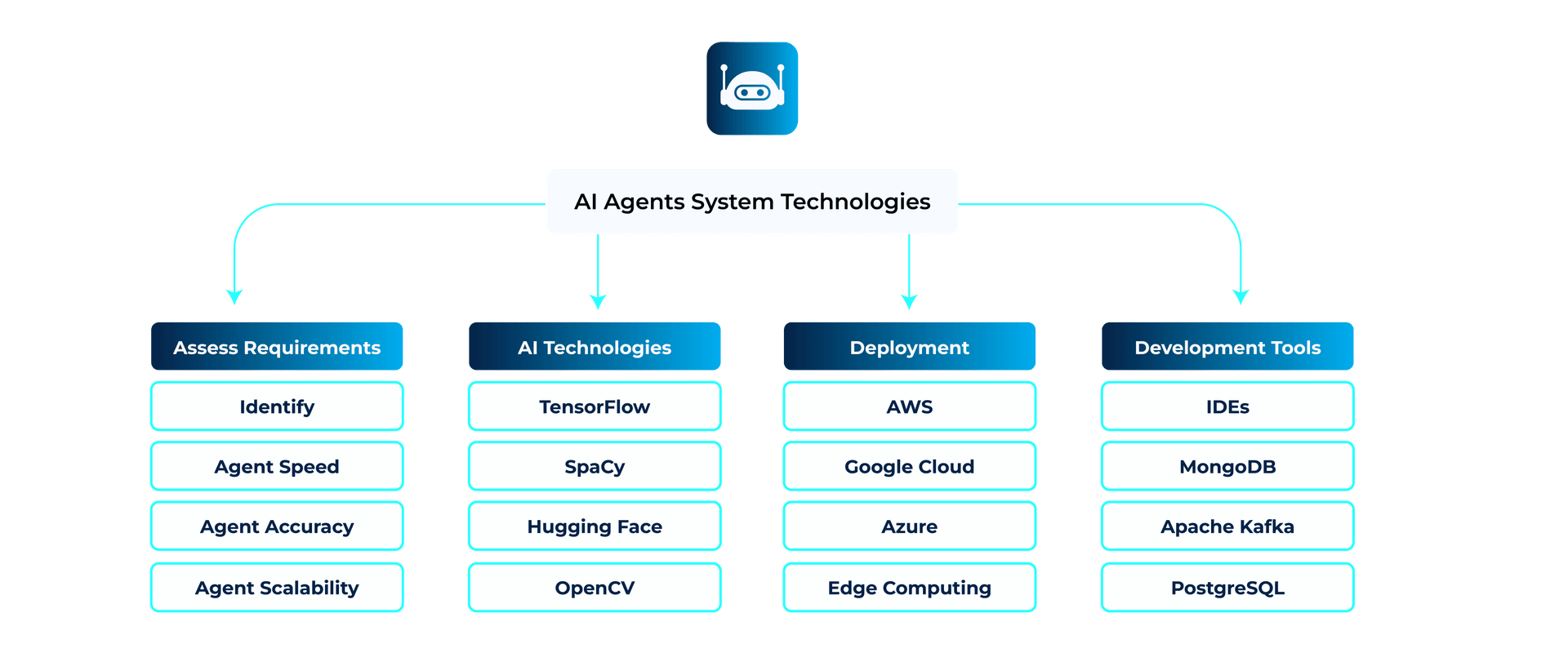A Beginner's Guide to Building an AI Agent
Artificial intelligence (AI), once limited to simple question-answer formats, has now advanced to agents capable of performing tasks as efficiently as humans.
These agents have also far surpassed virtual assistants like Siri and Alexa, showing significant potential in drug discovery in healthcare, fraud detection in finance, supply chain optimization in e-commerce, and so much more.
A survey of 1,100 executives from major enterprises found that 10% of firms already use AI agents, and 82% plan to incorporate them within the next three years.
Notably, 60% intend to build AI agents within a year, while a quarter foresee longer timelines.
To stay competitive, engage customers, and increase profits, it’s time for businesses to integrate this transformative technology. The question now is, how to build an AI agent?
Read on to find the answer
The Basics of Building and Training A Custom AI Agent

Building and training an AI assistant involves teaching it to understand and interact with human language in useful and relevant ways. The process essentially brings together 3 major concepts, i.e. machine learning (ML), natural language processing (NLP), and data labeling.
Let’s take a closer look at each of these.
1. Machine Learning
Machine learning allows AI systems to automatically learn and improve from experience without specific programming. In the training process, ML algorithms analyze data to identify patterns and make decisions.
2. Natural Language Processing
Natural language processing focuses on how computers can understand, interpret, and generate human language. For AI agents, NLP is what enables them to process large amounts of text and respond naturally.
3. Data Labeling
Data labeling plays a critical role in training AI agents. It involves assigning tags or labels to raw data, helping the system understand the context and meaning behind user inputs. For instance, labeling might include tagging sentence parts, identifying emotions in text, or classifying queries by topic.
How to Build an AI Agent with 7 Easy Steps to Follow
Building your own AI agent from scratch may seem daunting, but by breaking it down into manageable steps, you can simplify the process.
Here’s a step-by-step guide from defining your agent’s purpose to deploying and maintaining it.
1. Define the Agent’s Purpose and Scope
To build custom AI agents, first things first, define what you want them to achieve. This means deciding on the tasks and functions the agent will perform.
Consider these questions to clarify your goals:
- What are the AI agent’s capabilities? Will they sort documents, analyze customer interactions, or generate insights from data?
- What is the desired outcome? Are you aiming to improve customer service or automate repetitive processes?
- What data will the agent use? Identify sources such as structured data from databases or unstructured data from emails.
2. Assign the Development Team
Next, you’ll need to assemble a team to build and train your AI agent. You’ll likely need the following roles:
- Machine Learning Engineer
- Data Scientist
- Software Engineer
- DevOps engineer
You can choose to hire in-house or outsource these roles. Outsourcing may be a good choice if you have budget constraints or a small internal team.
3. Gather and Prepare Training Data
Data is the core of any AI agent. You need accurate, unbiased, and relevant data to ensure your AI functions well. Here are some sources to consider:
- Internal data consists sales records, customer info, operational data, etc.
- External data, including purchased datasets, data from providers, or publicly available data.
- User-generated data like social media posts, product reviews, and website interactions.
Once you’ve gathered the data, clean and preprocess it. Properly prepared data forms the foundation for training a high-performing AI agent.
4. Select the Right AI Technology and Tools

In this step, you’ll evaluate various technologies and select the ones that best suit your AI agent’s purpose, data, and needs. Here’s how to approach it:
AI Technologies
- Machine learning frameworks: Choose from popular frameworks like TensorFlow, PyTorch, and scikit-learn, depending on the complexity of your project and your familiarity with the tools.
- Natural language processing (NLP): If your agent needs to understand or generate human language, consider harnessing NLP libraries like spaCy and Hugging Face Transformers.
Deployment Options
Decide whether to host your agent on-premise or in the cloud. Cloud platforms like AWS, Google Cloud, or Azure offer scalability but might raise data security concerns.
Development Tools
- Integrated development environments (IDEs): Choose IDEs that streamline both your coding and testing workflows.
- Data management tools: Use tools like MongoDB for data storage or Apache Kafka for managing data pipelines.
5. Design the AI Agent
Now, it’s time to design your own AI agent system. This is where you lay the foundation for how the agent will work and how it will accomplish its tasks.
Decide on the Agent Architecture
The architecture defines how your AI agent is structured and functions. Selecting the right architecture facilitates efficient operation and ease of maintenance.
Consider the two following options:
- Modular design: Develop individual components (modules) of the AI agent separately and then integrate them. This approach allows for easier updates, debugging, and scalability since changes to one module don’t affect others.
- Concurrent design: Build a system where multiple tasks are executed simultaneously. This is ideal for agents handling real-time operations, such as managing various customer conversations simultaneously.
Define key functionalities
- Core functions: List the primary tasks the agent must perform, such as data input, processing, decision-making, and output generation (e.g., classifications, recommendations).
- User interaction: Design how users will interact with your agent, whether through interfaces, chatbots, or APIs that allow commands.
- Feedback mechanisms: Incorporate feedback systems to help your AI agent improve over time, especially in reinforcement learning scenarios.
6. Develop the AI Agent
The next stage is to develop the custom AI agent, which encompasses coding, integration, and testing to transform the conceptual design into a working system.
Once core features are in place, focus on integrating the AI agent with external systems necessary for its functionality. Here, you need to carry out API calls and database integrations.
- API connections: Connect your AI agent to external APIs that provide additional data or functionality.
- Database integration: Design and implement databases to store crucial information, such as user data, customer interactions, and operational logs.
Following that, to enable custom agents to learn and improve over time, you’ll need to incorporate machine learning and memory systems:
- Machine learning: Integrate libraries like TensorFlow and PyTorch to provide the agent with the ability to learn from new data. Whether supervised or unsupervised learning, the agent can continuously refine its responses or decisions based on new input.
- Memory systems: This might include using databases or in-memory systems to track user history, making the agent more personalized and effective.
7. Deploy and Monitor the AI Agent
With the agent developed and tested, you’re ready to deploy it into a real-world environment.
But first things first, before deployment, create an environment that mirrors your production system to test the AI agent’s performance in a near-live scenario. This guarantees that the agent’s operations won’t be compromised in real-world conditions.
After deployment, you need to continuously monitor the agent’s performance. This includes tracking response time, accuracy, and user satisfaction. By regularly collecting user feedback, you can identify areas for improvement and refine the agent’s functionality.
Challenges To Overcome When Building Your AI Agent
Building custom AI agents comes with its share of challenges. Below are major ones to keep in mind:
- Data quality and quantity: AI agents require extensive, high-quality data for training. Poor, biased, or insufficient data can lead to inaccurate or unfair decision-making.
- Algorithm selection and model complexity: Choosing the right algorithms and model architecture is a significant challenge. It’s essential to balance model complexity with interpretability.
- Real-time processing: For AI agents working in real time, maintaining a quick response time while ensuring accuracy is a difficult balancing act. Optimizing for speed without sacrificing performance can be daunting
- Scalability: As the use of AI agents grows, they must be able to handle more data, increase workloads, serve more users simultaneously, and maintain efficiency without decreasing performance.
- User interaction and experience: The agent must offer interactive interfaces and seamlessly meet user needs. Failing to understand user behavior can result in poor adoption and reduced effectiveness.
Final Thoughts
Building AI agents requires careful planning and execution across several key stages. Ready to put AI agents to work? At Impleko AI, we specialize in developing AI agents tailored to your unique needs. With years of expertise in AI, ML, NLP, GenAI, etc., our team can guide you through every step of the AI agent development process, from ideation to deployment.
Let’s create an AI agent that works for you!
